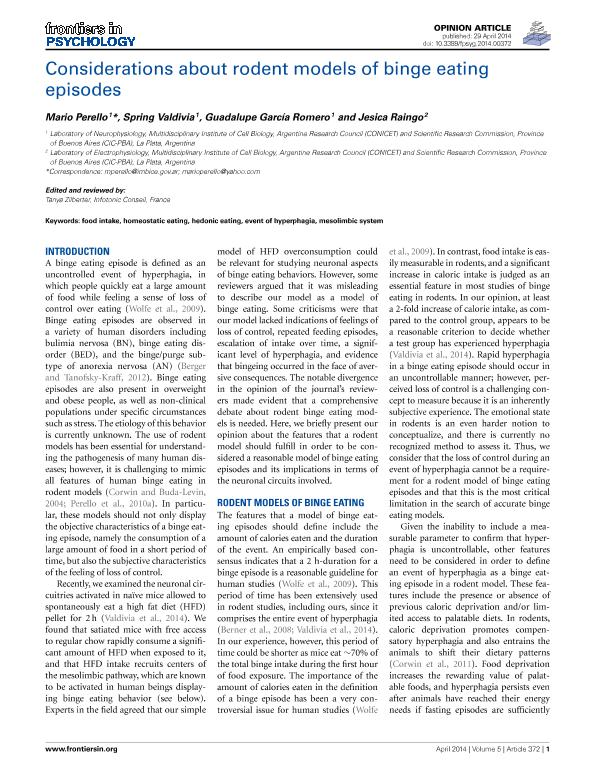Mostrar el registro sencillo del ítem
dc.contributor.author
Perello, Mario

dc.contributor.author
Valdivia Torres, Lesly Spring

dc.contributor.author
Garcia Romero, Guadalupe

dc.contributor.author
Raingo, Jesica

dc.date.available
2018-01-04T15:37:04Z
dc.date.issued
2014-04
dc.identifier.citation
Perello, Mario; Valdivia Torres, Lesly Spring; Garcia Romero, Guadalupe; Raingo, Jesica; Considerations about rodent models of binge eating episodes; Frontiers; Frontiers in Psychology; 5; 372; 4-2014; 1-4
dc.identifier.issn
1664-1078
dc.identifier.uri
http://hdl.handle.net/11336/32303
dc.description.abstract
A binge eating episode is defined as an uncontrolled event of hyperphagia, in which people quickly eat a large amount of food while feeling a sense of loss of control over eating (Wolfe et al., 2009). Binge eating episodes are observed in a variety of human disorders including bulimia nervosa (BN), binge eating disorder (BED), and the binge/purge subtype of anorexia nervosa (AN) (Berger and Tanofsky-Kraff, 2012). Binge eating episodes are also present in overweight and obese people, as well as non-clinical populations under specific circumstances such as stress. The etiology of this behavior is currently unknown. The use of rodent models has been essential for understanding the pathogenesis of many human diseases; however, it is challenging to mimic all features of human binge eating in rodent models (Corwin and Buda-Levin, 2004; Perello et al., 2010a). In particular, these models should not only display the objective characteristics of a binge eating episode, namely the consumption of a large amount of food in a short period of time, but also the subjective characteristics of the feeling of loss of control. Recently, we examined the neuronal circuitries activated in naïve mice allowed to spontaneously eat a high fat diet (HFD) pellet for 2 h (Valdivia et al., 2014). We found that satiated mice with free access to regular chow rapidly consume a significant amount of HFD when exposed to it, and that HFD intake recruits centers of the mesolimbic pathway, which are known to be activated in human beings displaying binge eating behavior (see below). Experts in the field agreed that our simple model of HFD overconsumption could be relevant for studying neuronal aspects of binge eating behaviors. However, some reviewers argued that it was misleading to describe our model as a model of binge eating. Some criticisms were that our model lacked indications of feelings of loss of control, repeated feeding episodes, escalation of intake over time, a significant level of hyperphagia, and evidence that bingeing occurred in the face of aversive consequences. The notable divergence in the opinion of the journal´s reviewers made evident that a comprehensive debate about rodent binge eating models is needed. Here, we briefly present our opinion about the features that a rodent model should fulfill in order to be considered a reasonable model of binge eating episodes and its implications in terms of the neuronal circuits involved.
dc.format
application/pdf
dc.language.iso
eng
dc.publisher
Frontiers
dc.rights
info:eu-repo/semantics/openAccess
dc.rights.uri
https://creativecommons.org/licenses/by-nc-sa/2.5/ar/
dc.subject
Food Intake
dc.subject
Homeostatic Eating
dc.subject
Hedonic Eating
dc.subject
Event of Hyperphagia
dc.subject.classification
Neurociencias

dc.subject.classification
Medicina Básica

dc.subject.classification
CIENCIAS MÉDICAS Y DE LA SALUD

dc.title
Considerations about rodent models of binge eating episodes
dc.type
info:eu-repo/semantics/article
dc.type
info:ar-repo/semantics/artículo
dc.type
info:eu-repo/semantics/publishedVersion
dc.date.updated
2018-01-03T19:05:15Z
dc.journal.volume
5
dc.journal.number
372
dc.journal.pagination
1-4
dc.journal.pais
Bélgica

dc.journal.ciudad
Bruselas
dc.description.fil
Fil: Perello, Mario. Consejo Nacional de Investigaciones Científicas y Técnicas. Centro Científico Tecnológico Conicet - La Plata. Instituto Multidisciplinario de Biología Celular. Provincia de Buenos Aires. Gobernación. Comisión de Investigaciones Científicas. Instituto Multidisciplinario de Biología Celular. Universidad Nacional de La Plata. Instituto Multidisciplinario de Biología Celular; Argentina
dc.description.fil
Fil: Valdivia Torres, Lesly Spring. Consejo Nacional de Investigaciones Científicas y Técnicas. Centro Científico Tecnológico Conicet - La Plata. Instituto Multidisciplinario de Biología Celular. Provincia de Buenos Aires. Gobernación. Comisión de Investigaciones Científicas. Instituto Multidisciplinario de Biología Celular. Universidad Nacional de La Plata. Instituto Multidisciplinario de Biología Celular; Argentina
dc.description.fil
Fil: Garcia Romero, Guadalupe. Consejo Nacional de Investigaciones Científicas y Técnicas. Centro Científico Tecnológico Conicet - La Plata. Instituto Multidisciplinario de Biología Celular. Provincia de Buenos Aires. Gobernación. Comisión de Investigaciones Científicas. Instituto Multidisciplinario de Biología Celular. Universidad Nacional de La Plata. Instituto Multidisciplinario de Biología Celular; Argentina
dc.description.fil
Fil: Raingo, Jesica. Consejo Nacional de Investigaciones Científicas y Técnicas. Centro Científico Tecnológico Conicet - La Plata. Instituto Multidisciplinario de Biología Celular. Provincia de Buenos Aires. Gobernación. Comisión de Investigaciones Científicas. Instituto Multidisciplinario de Biología Celular. Universidad Nacional de La Plata. Instituto Multidisciplinario de Biología Celular; Argentina
dc.journal.title
Frontiers in Psychology
dc.relation.alternativeid
info:eu-repo/semantics/altIdentifier/doi/http://dx.doi.org/10.3389/fpsyg.2014.00372
dc.relation.alternativeid
info:eu-repo/semantics/altIdentifier/url/https://www.frontiersin.org/articles/10.3389/fpsyg.2014.00372/full
Archivos asociados
